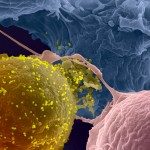Link to Pubmed [PMID] – 35246495
Link to DOI – 10.4049/jimmunol.2100275
J Immunol 2022 Mar; 208(6): 1389-1395
Mucosal-associated invariant T (MAIT) cells are innate-like T cells that are highly abundant in human blood and tissues. Most MAIT cells have an invariant TCRα-chain that uses T cell receptor α-variable 1-2 (TRAV1-2) joined to TRAJ33/20/12 and recognizes metabolites from bacterial riboflavin synthesis bound to the Ag-presenting molecule MHC class I related (MR1). Our attempts to identify alternative MR1-presented Ags led to the discovery of rare MR1-restricted T cells with non-TRAV1-2 TCRs. Because altered Ag specificity likely alters affinity for the most potent known Ag, 5-(2-oxopropylideneamino)-6-d-ribitylaminouracil (5-OP-RU), we performed bulk TCRα- and TCRβ-chain sequencing and single-cell-based paired TCR sequencing on T cells that bound the MR1-5-OP-RU tetramer with differing intensities. Bulk sequencing showed that use of V genes other than TRAV1-2 was enriched among MR1-5-OP-RU tetramerlow cells. Although we initially interpreted these as diverse MR1-restricted TCRs, single-cell TCR sequencing revealed that cells expressing atypical TCRα-chains also coexpressed an invariant MAIT TCRα-chain. Transfection of each non-TRAV1-2 TCRα-chain with the TCRβ-chain from the same cell demonstrated that the non-TRAV1-2 TCR did not bind the MR1-5-OP-RU tetramer. Thus, dual TCRα-chain expression in human T cells and competition for the endogenous β-chain explains the existence of some MR1-5-OP-RU tetramerlow T cells. The discovery of simultaneous expression of canonical and noncanonical TCRs on the same T cell means that claims of roles for non-TRAV1-2 TCR in MR1 response must be validated by TCR transfer-based confirmation of Ag specificity.
